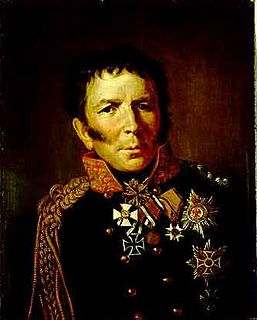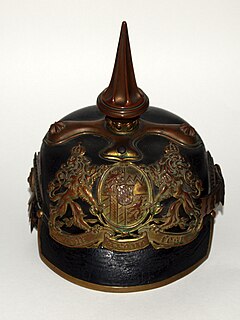 W
WThe Royal Prussian Army served as the army of the Kingdom of Prussia. It became vital to the development of Brandenburg-Prussia as a European power.
 W
WThe Royal Prussian Army was the principal armed force of the Kingdom of Prussia during its participation in the Napoleonic Wars.
 W
WThe Dreyse needle-gun was a military breechloading rifle. It is famous for having been the main infantry weapon of the Prussians in the Wars of German Unification. It was accepted for service in 1841 as the "leichtes Perkussionsgewehr Modell 1841"("light percussion rifle Model 1841"), with the name chosen to hide the nature of the new weapon. The name "Zündnadelgewehr"/"needle-gun" comes from its needle-like firing pin, which passed through the paper cartridge case to strike a percussion cap at the bullet base. The Dreyse rifle was also the first breech-loading rifle to use the bolt action to open and close the chamber, executed by turning and pulling a bolt handle. It has a rate of fire of about 6 rounds per minute.
 W
WJohann Nicolaus von Dreyse was a German firearms inventor and manufacturer. He is most famous for submitting the Dreyse needle gun in 1836 to the Prussian army, which was adopted for service in December 1840 as the Leichte Perkussions-Gewehr M 1841 – a name deliberately chosen to mislead about the rifle's mechanism – later renamed Zündnadelgewehr M 1841 in 1855.
 W
WThe Invalids' Cemetery is one of the oldest cemeteries in Berlin. It was the traditional resting place of the Prussian Army, and is regarded as particularly important as a memorial to the German Wars of Liberation of 1813–15.
 W
WKriegsspiel is a genre of wargaming developed by the Prussian army in the 19th century to teach battlefield tactics to officers. The word Kriegsspiel literally means "wargame" in German, but in the context of the English language it refers specifically to the wargames developed by the Prussian army in the 19th century. Kriegsspiel was the first wargaming system to have been adopted by a military organization as a serious tool for training and research. After Prussia's impressive victory over France in the Franco-Prussian War, other countries swiftly began designing Kriegsspiel-like wargames for their own armies.
 W
WThe Military Cabinet (Militärkabinett) was a military advisory body under the direct command of the King of Prussia, and by extension the German Emperor after 1871, for handling personnel matters of the army officer corps. It emerged from the Prussian Army personnel department in the wake of the 1809 reform of the military, and was officially established 3 June 1814. It developed under Emperor Wilhelm II into a personal instrument of the monarch for processing all military matters.
 W
WThe Pickelhaube, also Pickelhelm, is a spiked helmet that was worn in the 19th and 20th centuries by Prussian and German military, firefighters and police. Although it is typically associated with the Prussian Army, which adopted it in 1842–43, the helmet was widely imitated by other armies during that period. It is still worn today as part of ceremonial wear in the militaries of certain countries, such as Sweden, Chile, and Colombia.
 W
WPrussian virtues refers to the virtues associated with the historical Kingdom of Prussia, especially its militarism and the ethical code of the Prussian army, but also bourgeois values as influenced by Calvinism in particular. It has also significantly influenced wider German culture, such as the contemporary German stereotypes of efficiency, austerity and discipline.